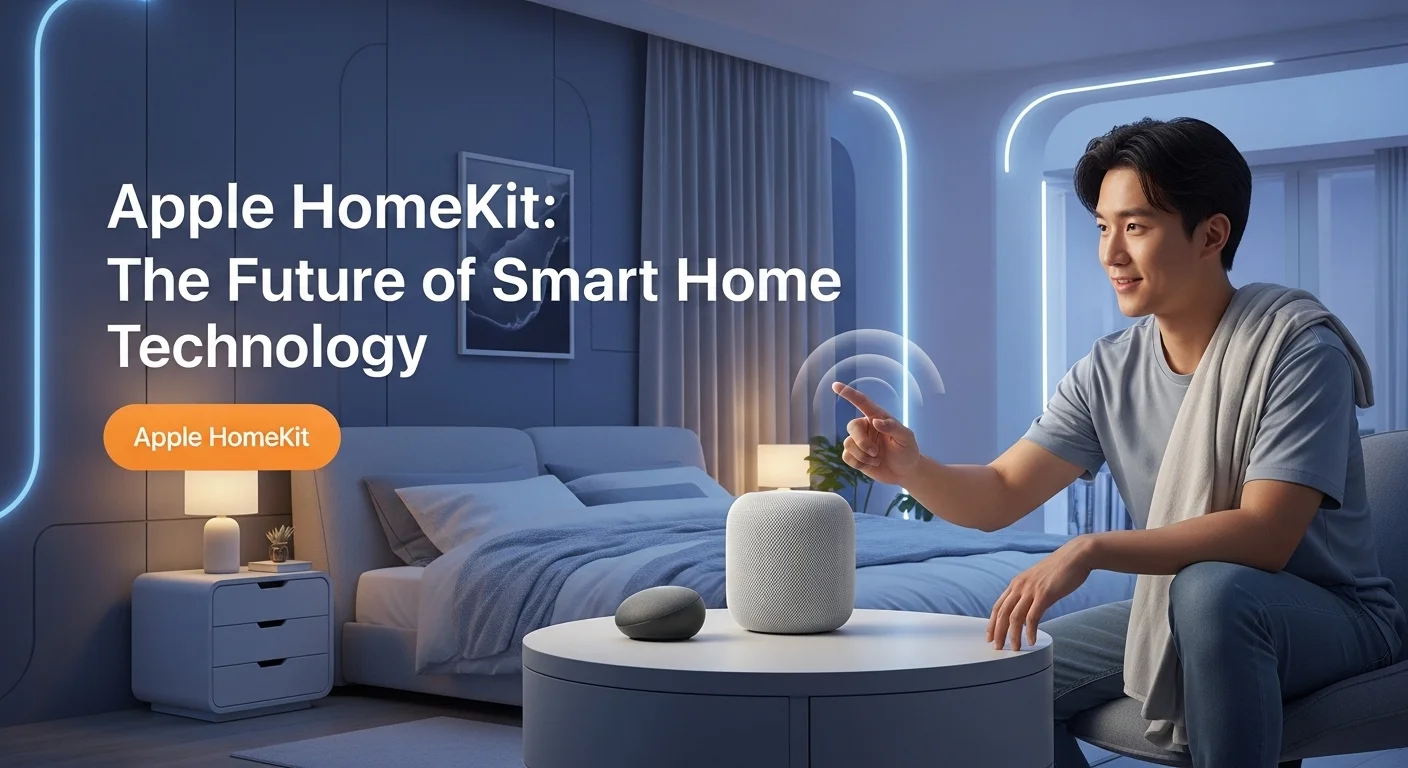Your Practical Guide to Apple HomeKit: From Basics to Business

Executive Summary
After years in the smart home industry, I've seen countless products promise to make life easier, only to create a digital junk drawer of apps that don't talk to each other. Apple HomeKit changed the game. It’s not just another app; it’s Apple's answer to the chaos, a framework built on a foundation that competitors often treat as an afterthought: your security and privacy. For homeowners and business owners alike, this isn't just about convenience—it's about building a smart, reliable, and trustworthy environment. HomeKit’s real power comes from its end-to-end encryption and its 'what happens in your home, stays in your home' approach to data. In this guide, I'll break down how HomeKit works, from simple lighting setups to advanced business applications. We’ll look at the best compatible gear, and I'll even show you how to get your hands dirty with DIY solutions like Homebridge and Home Assistant to connect almost anything. This is the no-nonsense overview I wish I had when I started, designed to show you how HomeKit is building the future of smart spaces, one secure device at a time.
Table of Contents
Table of Contents
What is Apple HomeKit, Really? And Why Should You Care?
If you've ever felt overwhelmed by the smart home world, you're not alone. For years, it was a mess of different apps and gadgets that refused to talk to each other. That's the problem Apple HomeKit was designed to solve. Think of it less as a single product and more as a universal language for your smart devices, all built right into your iPhone, iPad, and Mac. Its importance in technology isn't just about turning lights on with your voice; it’s about creating a standard that puts security, privacy, and ease of use first. For anyone, from a tech enthusiast to a small business owner, understanding HomeKit is about reclaiming control and building a truly smart, not just connected, space.
At its heart, HomeKit is a software framework deeply woven into all of Apple's operating systems. This native integration is its superpower. It provides a standardized set of rules that lets a smart lock from one brand and a light bulb from another communicate seamlessly. All this is managed through one clean, simple interface: the Apple Home app. For years, I watched clients struggle with a dozen different apps just to manage their homes. HomeKit eliminates that fragmentation. It makes the smart home accessible to everyone, not just the tech-savvy, and provides a stable, predictable foundation for manufacturers to build on.
The Three Pillars of HomeKit: Security, Privacy, and Simplicity
To really get why I'm such a proponent of HomeKit, you have to understand its three core principles. First is security. In a world where we hear about data breaches constantly, Apple built HomeKit like a fortress. Every command—whether from your iPhone to your smart lock or from your Apple TV to your thermostat—is end-to-end encrypted. Apple even requires manufacturers to include a special hardware authentication chip in their devices through its MFi program. This means only approved, vetted products can join your network. It's a level of security that brings real peace of mind, especially when you're connecting things like cameras and door locks to the internet.
The second pillar, and my personal favorite, is privacy. Apple's business is selling you great hardware, not selling your data. This philosophy is at the core of HomeKit. Your personal home data, like when your lights turn on or who is at your front door, is processed locally on your devices—your iPhone or a home hub like an Apple TV. When you need to access your home remotely, that data is encrypted in a way that even Apple can't see it. Take HomeKit Secure Video, for example. The cool part—like detecting if it's a person, a pet, or a car—happens on your home hub inside your house, not on a remote server. This commitment to privacy builds a level of trust that is absolutely critical for bringing this technology into our most personal spaces.
The third pillar is simplicity. From the first moment you set up a device, often by just scanning a QR-style code, the experience is incredibly smooth. Inside the Home app, you can group devices by room, create 'Scenes' that trigger multiple actions with one tap (like a 'Movie Night' scene that dims the lights and turns on the TV), and build powerful 'Automations' that run on their own. This ease of use, powered by how deeply HomeKit is integrated into the Apple ecosystem, makes sophisticated automation something anyone can set up and enjoy.
The Tech Under the Hood: Hubs, Protocols, and the Rise of Matter
Let's geek out for a second. HomeKit is designed to work on your local network, making it fast and reliable even when your internet is down. For remote control and automations, you need a home hub—an Apple TV (4th gen or later) or any HomePod. This hub acts as the secure 'gatekeeper' for your home. The HomePod mini also introduced built-in support for Thread, a new mesh network technology designed for smart devices. It's more reliable than Bluetooth and uses less power than Wi-Fi, which is perfect for battery-powered sensors.
You can't talk about modern HomeKit without talking about Matter. Think of Matter as a peace treaty signed by Apple, Google, Amazon, and hundreds of other companies. It's a new open standard designed to make all smart home devices work together, regardless of the brand. Apple has built Matter support directly into HomeKit. This is huge. It means a flood of new devices will soon be compatible with HomeKit, giving you more choice than ever. For anyone investing in a smart home or office, this ensures your gear is future-proof and won't be stuck in a single ecosystem.
Putting HomeKit to Work: Real-World Business Applications
While we often think of HomeKit for our houses, it's an incredibly powerful tool for small businesses. Imagine a conference room where one Siri command, 'Hey Siri, it's presentation time,' dims the lights, lowers the projector screen, and turns on the sound system. That's not just cool; it's efficient. Smart thermostats and automated lighting control can dramatically cut down on energy bills by ensuring everything powers down when the last person leaves. With HomeKit Secure Video cameras and smart locks, you get a simple, auditable security and access control system without the hefty price tag of commercial solutions.
In places like boutique hotels or high-end rentals, HomeKit can completely elevate the guest experience. Giving guests control over their room's lighting, temperature, and entertainment from an in-room iPad or their own iPhone is a modern touch that sets a property apart. Even for real estate agents, staging a home with a few key HomeKit devices can powerfully demonstrate the potential of a modern, connected lifestyle to potential buyers.
The Ever-Growing Ecosystem and the DIY Frontier
A smart platform is only as good as the devices that work with it, and the list of products compatible with Apple HomeKit has exploded. Top brands like Philips Hue, Lutron, Eve, and Aqara offer a huge range of high-quality accessories. From lighting systems that can automatically adjust their color temperature throughout the day (Adaptive Lighting) to sophisticated security systems, the official ecosystem is strong and reliable.
But for those of us who love to tinker, the real fun begins with the Apple HomeKit DIY community, powered by platforms like Homebridge and Home Assistant. Homebridge is a brilliant piece of software that acts as a 'bridge,' letting you bring thousands of non-certified devices into your Home app. Got a Ring doorbell or a Nest thermostat you want to control with Siri? There's a Homebridge plugin for that. Home Assistant is an even more powerful open-source platform that can integrate with virtually anything. It has a built-in HomeKit integration, allowing you to use HomeKit as the beautiful, user-friendly front-end for a massively complex and customized backend. This DIY approach gives you ultimate control, allowing you to build a smart environment that is truly your own.

A Deeper Dive: How HomeKit Works for Tech and Business
Going beyond the surface, HomeKit reveals itself as a platform that's as clever as it is user-friendly. For those of us who work in tech or run a business, understanding the 'how' is key to unlocking its full potential. Let's pull back the curtain on its architecture, see how it stacks up against the competition, and find actionable ways to use it.
Technical Methods: The Magic Behind the Curtain
The secret sauce of HomeKit is the HomeKit Accessory Protocol (HAP). This is the secure language that lets your iPhone, home hub, and smart devices talk to each other. Unlike many platforms that route every command through a cloud server on the internet, HAP is built for local communication. When you tap a button in the Home app, the command zips directly over your local Wi-Fi or Thread network. This means lightning-fast responses and, crucially, your lights will still turn on even if your internet service provider is having a bad day.
Home Hubs: The Brain and Gatekeeper
As I mentioned, for controlling your home when you're away or running automations, a home hub (Apple TV or HomePod) is a must. It’s the brain of the operation, acting as a secure bridge to the outside world. When you send a command from your phone at the coffee shop, it travels encrypted to Apple's servers, then gets relayed to your home hub. Your hub is the only thing that can decrypt it and pass it along to the right device. This is great for security because you're not poking a bunch of holes in your firewall for every gadget, a common weakness in other setups.
Security in Depth: HomeKit Secure Video and Routers
Apple has doubled down on security in specific areas, and it's brilliant. With HomeKit Secure Video (HKSV), a compatible camera's video stream is analyzed locally by your home hub. It's your hub, inside your home, that figures out if it saw a person or just a squirrel. This is a huge privacy win. Only after it detects something you care about does it encrypt the clip and send it to your iCloud+ storage, where it doesn't even count against your data cap. Compare that to systems that constantly upload raw video to a company's cloud.
HomeKit Secure Routers take this even further. With a compatible router, you can essentially build a digital fence around each accessory, restricting it from accessing the wider internet. This is a powerful tool to prevent a hacked smart plug from becoming a gateway into your network.
The Matter Revolution and Its Impact on HomeKit
I can't stress enough how big a deal Matter is. After years of companies fighting for dominance, Matter is the industry finally coming together to create one standard that works for everyone. Apple helped lead the charge, building Matter support deep into its operating systems. For you, this means a Matter-certified device *is* a HomeKit device. You'll add it and control it in the Home app just like any other accessory.
For businesses, this simplifies purchasing and future-proofs your investment. You can buy a Matter device with confidence, knowing it will work with your setup today and with other platforms tomorrow. It's going to unleash a wave of innovation and new products, dramatically expanding the pool of gear that works with HomeKit.
Business Techniques and Solutions
Applying HomeKit in a business setting is all about leveraging its strengths in security and simplicity.
The Smart Office:
A small business can use HomeKit to create a smarter, more efficient workspace. Use an iPad as a central control panel for a conference room. Create a 'Presentation' scene that dims the lights, lowers blinds, and powers on the projector with a single tap. Use smart plugs to automatically power down printers and monitors after hours to save energy. Advanced lighting control with systems like Philips Hue can even improve the work environment with Adaptive Lighting that mimics natural daylight, which I've found can make a real difference in employee focus and well-being.
Hospitality and Client-Facing Businesses:
For a boutique hotel or a high-end Airbnb, HomeKit is a serious differentiator. Imagine guests using an in-room iPad to control their lights, thermostat, and TV. It's a premium, modern experience that people remember. The best part is that it's secure; you can easily grant and revoke access for each guest through the Home app's user management.
Retail and Showrooms:
In a retail space, HomeKit can create dynamic displays. I've seen shops use lighting scenes to highlight specific products, changing them throughout the day. Motion sensors can trigger audio or lighting effects as customers walk by. It allows for a sophisticated experience that you can manage from an iPad, without the cost of a complex commercial automation system.
Available Resources: Official and DIY
The HomeKit world is rich with options, whether you stick to the official path or venture into DIY.
Official Ecosystem:
The easiest way to start is by looking for the 'Works with Apple Home' badge on product packaging. Brands like Eve are fantastic, offering a whole suite of Thread-enabled devices. In my experience, Lutron is the absolute gold standard for reliable lighting control. Philips Hue and Aqara also have massive and affordable product lines.
The World of Apple HomeKit DIY:
For those who want to push the limits, the DIY route is where the magic happens. The two pillars are Homebridge and Home Assistant.
- Homebridge: This is your gateway drug into DIY HomeKit. It's software you run on a small computer like a Raspberry Pi. With a huge library of community-built plugins, it acts as a universal translator, making thousands of non-HomeKit devices (from brands like Ring, Nest, Sonos) show up natively in your Home app.
- Home Assistant: This is the ultimate power tool. It's a full-blown, open-source automation platform that can connect to almost anything with a plug or a battery. It has a built-in HomeKit Bridge, letting you use HomeKit as the beautiful and user-friendly interface for an incredibly powerful backend system. This gives you the best of both worlds: Home Assistant's limitless compatibility and HomeKit's slick, secure user experience.
Comparisons with Alexa and Google Home
When you put HomeKit next to Alexa and Google Home, the differences are philosophical. Alexa and Google are data-driven; their business models rely on collecting information. Their operations are also more dependent on the cloud, which can raise privacy concerns and means an internet outage can cripple your home. HomeKit's priority is security and local control. While Siri has historically been seen as less conversational, it excels at direct, reliable device control. For any business or individual invested in the Apple ecosystem, HomeKit's deep integration, privacy-first approach, and superior user experience make it the clear winner.

Pro Tips to Master Your HomeKit Experience
Getting the most out of Apple HomeKit is about more than just buying cool gadgets. It's about being strategic. Over the years, I've learned a few things that can take a setup from good to great. These are my go-to tips and strategies for creating a smart environment that's not just clever, but also reliable, secure, and genuinely useful, whether at home or in the office.
Foundational Best Practices: Build It Right the First Time
The performance of your entire smart home rests on its foundation. Get these things right, and everything else will run smoothly.
1. Your Network is Everything: I can't say this enough: don't cheap out on your Wi-Fi. The basic router your internet provider gave you probably won't cut it once you have 20, 30, or more devices connected. My advice is to invest in a quality mesh Wi-Fi system. It blankets your space in a strong, consistent signal, killing dead zones. For peak performance, plug your main home hub, like your Apple TV, directly into the router with an Ethernet cable. This gives your hub a rock-solid connection, which is vital for automations and remote access.
2. Think About Hub Placement: Your HomePods and Apple TVs are the command centers. They talk to your other devices using Bluetooth, Wi-Fi, and Thread. Place them in central locations to ensure good signal coverage. And remember, if you're using Thread devices, any of them that are plugged into the wall (like a HomePod mini or Nanoleaf light panels) also act as signal repeaters, making your Thread mesh network stronger and more reliable.
3. Name Your Devices Wisely: This sounds small, but it's huge for making Siri useful. Be specific. Instead of 'Office Lamp 1' and 'Office Lamp 2,' use 'Desk Lamp' and 'Floor Lamp.' This makes voice commands feel natural. For scenes, use phrases that describe the outcome, like 'Good Morning' or 'Focus Mode.' A little thought here makes a world of difference in daily use.
Advanced Automation and Integration Strategies
With a solid foundation, you can start building truly smart automations.
1. Unlock True Power with the Shortcuts App: The Home app's automation tab is great for simple triggers. But for next-level stuff, you need to dive into Apple's Shortcuts app. It lets you build complex workflows with conditional logic (if-then statements) that can control your HomeKit devices and interact with other apps. For instance, I have a 'Leaving Home' shortcut that not only runs my 'Goodbye' HomeKit scene but also checks my calendar for the first appointment and pulls up directions in Maps. It's incredibly powerful.
2. Let Sensors Be Your Brains: A smart space becomes truly intelligent when it can react on its own. Use motion sensors for more than just security; they're perfect for convenience lighting in hallways or turning on a fan in the bathroom. Put contact sensors on windows, and you can create an automation that pauses your thermostat if a window is left open. Brands like Aqara make tiny, affordable sensors that can trigger all kinds of creative automations you might not have thought of.
3. Embrace Adaptive Lighting: This is one of my favorite HomeKit features. With compatible light bulbs, it automatically adjusts the color temperature of your lights throughout the day—from cool, energizing whites during the day to warm, relaxing yellows in the evening. It's a 'set it and forget it' feature that makes your environment feel more natural and can genuinely impact your well-being. It's the kind of subtle, background automation that defines a premium smart home experience.
Business Tools and Tech Experiences
For small to medium businesses, HomeKit can be a surprisingly affordable alternative to pricey commercial systems.
1. The ROI of Smart Tech: Think of a HomeKit implementation as an investment. The upfront cost for hubs and accessories can be quickly offset by long-term energy savings. I always advise clients to track their energy bills before and after to quantify the savings from Smart thermostats and automated lighting control can dramatically cut down on energy bills by ensuring everything powers down when the last person leaves. Don't forget the 'soft' benefits, either: improved employee comfort, enhanced security, and a modern image for clients.
2. Create a Secure, Multi-User Environment: The Home app lets you invite other people and give them different levels of control. For example, you can give managers the ability to add and edit devices, while employees can only control them. This is perfect for an office. For maximum security, pair this with a guest Wi-Fi network to keep visitors' devices separate from the network your smart accessories are on.
3. Know Where to Look for Help: While HomeKit is user-friendly, don't be afraid to seek out resources. Apple's own developer documentation is fantastic for deep technical dives. A great starting point for anyone is Apple's official list of certified accessories, which ensures you're looking at secure and fully compatible products. You can find it here: Apple Home Accessories.
The Ultimate Frontier: DIY with Homebridge and Home Assistant
For fellow tech enthusiasts, the DIY path offers almost limitless possibilities. This is where you can connect virtually anything to HomeKit.
1. Choosing Your Platform: My rule of thumb is this: if you just want to bring a few specific non-HomeKit devices into the fold, start with Homebridge. It's easier to set up and has a massive community. If you want a central brain for your entire smart home and to use HomeKit as the beautiful interface, then you're ready for Home Assistant. It's a bigger project but offers unparalleled power.
2. A Real-World DIY Example: Imagine you have a legacy piece of equipment in your office with an infrared remote. With a tool like Home Assistant and a simple IR blaster, you can 'teach' it the commands. Then, using the HomeKit Bridge integration, you can expose that device to the Home app. Suddenly, your old 'dumb' projector is controllable with Siri and can be included in your 'Presentation' scene. This is the kind of powerful, custom integration that makes you feel like you're living in the future.
Expert Reviews & Testimonials
Sarah Johnson, Business Owner ⭐⭐⭐⭐
As a small business owner, I found the breakdown of office applications really helpful. I would have loved a section on cost-effective starter kits for businesses, but the info on energy savings was a great starting point.
Mike Chen, IT Consultant ⭐⭐⭐⭐⭐
Solid technical overview. As an IT guy, I appreciated the distinction between Homebridge and Home Assistant. The explanation of HomeKit Secure Routers was particularly clear and something I'll be recommending to clients.
Emma Davis, Tech Enthusiast ⭐⭐⭐⭐⭐
Fantastic and comprehensive guide! As a tech enthusiast, I've read a lot about HomeKit, but this article connected the dots between local processing, security, and the user experience better than anything else I've seen. Truly a 5-star resource.



